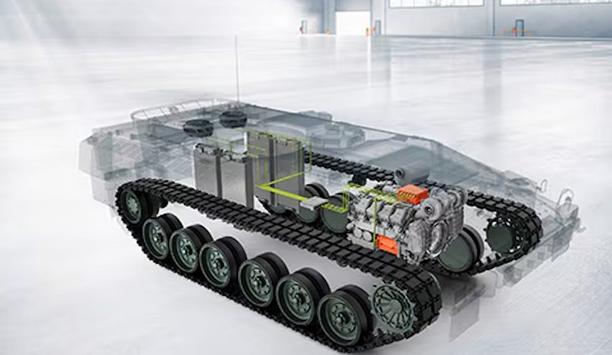Rolls-Royce plc - Experts & Thought Leaders
Latest Rolls-Royce plc news & announcements
Rolls-Royce held a successful F130 engine Critical Design Review (CDR), clearing the way for final development, test, and production efforts to proceed and taking another step towards delivering the upgraded B-52J to the United States Air Force. This milestone is the culmination of over two years of detailed design work and close collaboration between teams at Rolls-Royce, the Air Force and Boeing. The engine testing program is on track to begin altitude testing in February 2025 at the U.S. Air Force Arnold Engineering Development Complex in Tullahoma, Tennessee. Partnership with the U.S. Air Force and Boeing Candice Bineyard, Director, Early Life Cycle & Naval Programs – Defense, said: "We’re extremely proud to have delivered the F130 CDR milestone on-time for the B-52J, and grateful for our continued partnership with the U.S. Air Force and Boeing." Candice Bineyard adds, "Throughout the detailed design phase, our teams have executed a rigorous process in close collaboration with our partners. We’re excited to start the production work to deliver this incredible and highly reliable engine for the B-52J." Rolls-Royce’s Indianapolis facilities Sea-level testing gathered vital act data by driving the initial software out for the engine in Test Cell 114 Rolls-Royce also recently completed the first phases of F130 sea-level tests in its Indianapolis facilities and wrapped up Rapid Twin Pod Tests at NASA Stennis Space Centre this summer. Sea-level testing gathered critical performance data by running the initial software release for the engine in Test Cell 114. The test cell was recently revamped as part of a $1 billion investment in modernising Rolls-Royce’s Indianapolis facilities to deliver innovation and advanced manufacturing for the Air Force and other customers with American labour. Integration of the F130 engine The F130 engines will be manufactured, assembled and tested in Indianapolis, Rolls-Royce’s largest production facility in the U.S. Testing at NASA Stennis marked the first time F130 engines were tested in the dual-pod engine configuration of the B-52 aircraft. Rapid Twin Pod Tests played a key role in validating Rolls-Royce’s analytical predictions, further de-risking the integration of the F130 engine onto the B-52J and meeting test goals.
Rolls-Royce is developing new and advanced concepts to show navies how they can meet the growing challenges of undersea national defence. These include a significantly more powerful mtu submarine charging unit and mtu NautIQ automation systems for underwater ship control. Both will be unveiled by Rolls-Royce Power Systems at the Euronaval naval exhibition taking place from 4 to 7 November in Paris, France, underlining Rolls-Royce's role as a solutions provider in this special area of shipbuilding. Onboard power generator The latest and future generations of submarines require more electrical power than their predecessors. This is due, on the one hand, to the ever more extensive electronic equipment of the submarines. On the other hand, the modern battery storage systems on the ships allow faster charging than before. At the same time, there is a need for a space-saving design. Rolls-Royce is addressing these requirements with the concept of a more powerful mtu onboard power generator driven by the future 20-cylinder version of the mtu Series 4000 submarine engine. Twelve-cylinder boat engine With eight more cylinders, the 20-cylinder version will have a correspondingly higher power output Like the twelve-cylinder boat engine, of which many units have already been built, it is based on the marine version of the mtu Series 4000. With eight more cylinders, the 20-cylinder version will have a correspondingly higher power output. This means that the batteries can be charged much faster, minimising the surface time for the submarine. Compact genset Furthermore, the compact genset makes it possible to save space in the submarine hull, for example by having two of the 20-cylinder on-board power generators take over the tasks of the previous three smaller gensets. Compared to the surface version, the submarine variant has been modified in its charge air and combustion systems so that the boats are difficult to locate. The company has conducted a study that proves such a charging unit is suitable for integration into modern submarine designs. mtu NautIQ: underwater ship automation The system, which integrates numerous standard systems, controls the propulsion system and power supply With the mtu NautIQ Master automation system, Rolls-Royce Power Systems is extending its offering to include sophisticated, integrated control and monitoring systems for sub-surface platforms. The system, which integrates numerous standard systems, controls both the propulsion system and the power supply, monitors the condition of the units, and can be expanded with a range of modules such as damage control, onboard training, alarm and monitoring, navigation, and communication systems. This means that all integrated systems can be controlled via a standardised user interface. Naval surface vessels mtu NautIQ Master has already proven itself for naval surface vessels. Rolls-Royce is applying this experience underwater as well. This means that Rolls-Royce is also moving up from component supplier to solution provider in the submarine market.
Rolls-Royce’s Power Systems division is expanding its mtu engine programme for military land vehicles to include a hybrid powerpack for special tactical requirements and a 10-cylinder, over 1.100 kW power output, version of the mtu Series 199 which has been extremely successful with NATO forces. Both concepts will celebrate their premiere at the Eurosatory defence trade fair, which takes place in Paris from 17 to 21 June. Rolls-Royce's strategic initiatives Dr Jörg Stratmann, CEO of Rolls-Royce Power Systems said: "This underlines the importance we attach to our partnership with NATO countries and their allies in safeguarding their security interests. Because cooperation with the security authorities is one of Rolls-Royce's strategic initiatives, we will continue to be a reliable partner as a supplier of propulsion systems for military vehicles with our decades of technological expertise.” Rolls-Royce highlighted the governmental trade within Power Systems as an area of future Last year, at its Capital Markets Day, Rolls-Royce highlighted the governmental business within Power Systems as an area of future near-term growth through investment and expanding the scope of its products, including providing more integrated solutions. Offering new tactical options Knut Müller, Senior Vice President of Global Governmental Business at Rolls-Royce Power Systems said: "Future armoured military land vehicles will require more power for propulsion and on-board power supply for the electronic systems." "At the same time, they will be designed for a different tactical approach in the field. Our future mtu propulsion solutions for this application take both of these requirements into account.” Electrification and hybridisation will give tactical vehicles new capabilities in the field Electrification and hybridisation will give tactical vehicles new capabilities in the field. To this end, Rolls-Royce’s new mtu hybrid drive combines the advantages of a high-performance diesel engine with those of a battery-electric drive. The highly integrated propulsion system requires comparatively little installation space in the vehicle in order to maximise the volume available for equipment and crew. The core of the solution is a highly mobile and extremely compact drive solution, taking into account increasing cost pressure, tight budgets and the need for significantly larger vehicle fleets. Vehicle’s electrical and electronic systems For quiet operation, for example in a concealed position, the high-performance batteries previously charged in diesel mode, supply the vehicle’s electrical and electronic systems. This is done without the noise and thermal footprint of the diesel engine - and over a longer period of time. This makes the vehicle more difficult to locate for enemy reconnaissance. The so-called “anti-idling” mode not only ensures better camouflage of the vehicle, but also significantly reduces fuel consumption when the vehicle is on standby. The range of the vehicles and the downstream logistics chain for refuelling the vehicles are optimised. Hybrid main propulsion The noise generated by the drive is reduced to a minimum, making it considerably The advantages of “mild” hybridisation are demonstrated by the combined drive on slow journeys, when the vehicle tracks generate little noise. The noise generated by the drive is reduced to a minimum, making it considerably more difficult to detect the vehicle. Rolls-Royce uses a specially developed and customised silencer in combination with the hybrid main propulsion. In combined operation, the electric propulsion also serves as a booster for highly dynamic acceleration, noise-reduced low-speed driving or even high-speed driving. “This allows us to utilise the advantages of hybridisation in all operating modes,” emphasises Müller. Defence capabilities of NATO Christian Wolf, Head of Development for Military Engines and Systems at Rolls-Royce Power Systems said: “This propulsion concept will expand the operational possibilities of future tracked armoured vehicles in a way that was previously hardly imaginable. We are convinced that we are making an important contribution to the further development of the defence capabilities of NATO and its allies." "For the first time, vehicle manufacturers will be able to realise completely new vehicle concepts, whereby the hybrid concept can in principle be implemented with any engine series from the mtu military propulsion programme.” 10V 199 with over 1.100 kW power An engine series that has proven itself in the field is getting a new generation An engine series that has proven itself in the field is getting a new generation. The mtu Series 199 with outputs from 260 to 800 kW is well known in many military land defence programmes and has proven itself in all extreme climatic conditions in more than 15 countries. With the future 10-cylinder variant, the concept of which is being presented at the Eurosatory defence trade fair, the 199 series will cover a power range of up to 1.100 kW and will also be able to power vehicles weighing 50 to 70 tonnes. The logistical uniformity, with identical components within this engine family from the six-cylinder to the 10-cylinder variants, will help the armed forces to significantly reduce their logistics costs. Modular design principle Christian Wolf said: “In the next step, we have set our sights on a further increase in output to 1,200 kW.” Thanks to the modular design principle of the mtu Series 199 and its compact dimensions, the 10-cylinder engine can be used not only for new vehicles but also for the repowering of existing vehicles. The 10-cylinder version will set new standards in terms of power density, compact design and, above all, already available add-on parts such as hydraulic units, air compressors and generators for power generation. This will significantly simplify vehicle integration into a Powerpack. Six- and eight-cylinder models 10-cylinder engine has numerous product features in common with the six- and eight-cylinder models The 10-cylinder engine has numerous product features in common with the six- and eight-cylinder models of the mtu Series 199, which have made the Series 199 the best-selling engine series for military vehicles in its class: high power density with a small design volume; fast response behaviour; configurable according to vehicle requirements, for example with a generator or other add-ons; a wide range of options for power take-offs (so-called PTOs); and low lifecycle costs due to long maintenance intervals. Knut Müller said: “With this engine, which is based on a commercial basic engine, we are helping to meet the increased requirements for national and alliance defence in a cost-efficient manner.” Generation of US combat vehicles The mtu Series 199 has written an unrivalled success story with around 4000 units produced since 2000. The six- and eight-cylinder variants are used, for example, in the Boxer 8x8 wheeled vehicle, the tracked vehicles based on the ASCOD platform; the Ajax family vehicles; the next generation of US combat vehicles such as the M10 Booker; and the Borsuk infantry fighting vehicle.













































